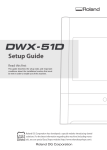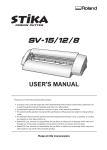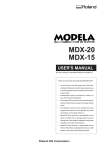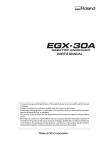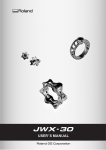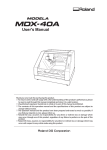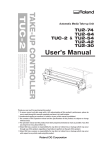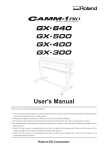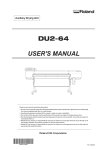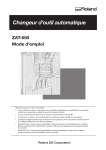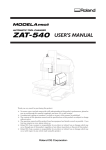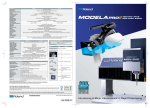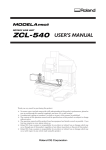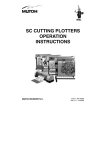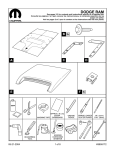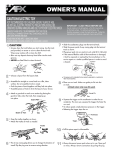Download USER`S MANUAL
Transcript
USER'S MANUAL Thank you very much for purchasing this product. To ensure correct and safe usage with a full understanding of this product's performance, please be sure to read through this manual completely and store it in a safe location. Unauthorized copying or transferral, in whole or in part, of this manual is prohibited. The contents of this operation manual and the specifications of this product are subject to change without notice. The operation manual and the product have been prepared and tested as much as possible. If you find any misprint or error, please inform us. Roland DG Corp. assumes no responsibility for any direct or indirect loss or damage which may occur through use of this product, regardless of any failure to perform on the part of this product. Roland DG Corp. assumes no responsibility for any direct or indirect loss or damage which may occur with respect to any article made using this product. Contents Contents....................................................................................................................................... 1 To Ensure Safe Use....................................................................................................................... 4 Pour utiliser en toute sécurité................................................................................................... 12 Important Notes on Handling and Use....................................................................................... 21 Chapter 1 Introduction ................................................................................................................... 23 1-1 Introduction ........................................................................................................................ 24 Features ...........................................................................................................................................................................................24 Installable Model .........................................................................................................................................................................24 Organization of the Documentation ....................................................................................................................................24 1-2 Names and Functions ........................................................................................................ 25 External View..................................................................................................................................................................................25 VPanel ..............................................................................................................................................................................................26 Chapter 2 Installation...................................................................................................................... 27 2-1 Before Installing ................................................................................................................. 28 Checking the Included Items ..................................................................................................................................................28 Preparing the Compressed-air Source .................................................................................................................................29 Preparing the Tool Holders ......................................................................................................................................................30 Overview of the Installation Procedure ...............................................................................................................................31 Required Setup Operations for the ATC-equipped Models..........................................................................................31 2-2 Step 1: Attach the Control Box ........................................................................................... 32 Attach the Control Box ..............................................................................................................................................................32 2-3 Step 2: Attach the Magazine Unit ....................................................................................... 33 For a Standard Table ...................................................................................................................................................................33 For a T-slot Table ..........................................................................................................................................................................36 2-4 Step 3: Attach the Spindle and Cylinder............................................................................. 39 Attach the Spindle and Cylinder.............................................................................................................................................39 2-5 Step 4: Connect and Secure the Cables ............................................................................ 42 Connect and Secure the Cables..............................................................................................................................................42 2-6 Step 5: Supply Compressed Air ......................................................................................... 45 Supply Compressed Air .............................................................................................................................................................45 2-7 Step 6: Adjust the Tool-change Location ............................................................................ 46 Adjust the Tool-change Location ...........................................................................................................................................46 Chapter 3 Basic Operation.............................................................................................................. 49 3-1 Starting and Quitting .......................................................................................................... 50 How to Start the Machine ........................................................................................................................................................50 How to Shut down ......................................................................................................................................................................51 3-2 Mounting the Tool Holders ................................................................................................. 52 Mounting Tool Holders in the Magazine .............................................................................................................................52 About the Stocker Numbers.....................................................................................................................................................54 3-3 Manual Tool-change ........................................................................................................... 55 Grasping a Tool Holder by Manual Operation ...................................................................................................................55 Chapter 4 Tool-length Offset........................................................................................................... 57 4-1 What's the Tool-length Offset? ........................................................................................... 58 What's the Tool-length Offset? ...............................................................................................................................................58 How to Determine the Adjustment Values.........................................................................................................................58 4-2 Automatic Measurement of Tool Length ............................................................................. 59 What's Automatic Measurement of Tool Length? ...........................................................................................................59 Automatic-measurement Procedure ...................................................................................................................................59 4-3 Entering Adjustment Values Yourself ................................................................................. 62 1 Contents Entering Adjustment Values ....................................................................................................................................................62 Fine-tuning the Results of Automatic Measurement of Tool Length........................................................................63 4-4 Starting Tool-length Offset .................................................................................................. 64 When Tool-length Offset Starts ..............................................................................................................................................64 Tool-length Offset in a Manual Tool-change .....................................................................................................................64 Correspondences Between Stocker Numbers and Offset Numbers ..........................................................................................64 Chapter 5 Getting Ready for and Performing Cutting.................................................................. 65 5-1 Cutting Area ....................................................................................................................... 66 Workpiece Size and Location Where Secured in Place...................................................................................................66 Actual Size That Can Be Cut .....................................................................................................................................................67 5-2 Examples of Usage of Tool-length Offset (RML-1 Mode).................................................... 68 Example of Operations up to Starting Cutting .................................................................................................................68 Example of Setting the Z-axis Origin ....................................................................................................................................68 5-3 Examples of Usage of Tool-length Offset (NC-code Mode)................................................ 69 Example of Operations up to Starting Cutting .................................................................................................................69 Example of Setting the Z-axis Origin ....................................................................................................................................70 Chapter 6 Handy Panel.................................................................................................................... 71 6-1 Features Added to the Handy Panel .................................................................................. 72 Features Added to the Handy Panel .....................................................................................................................................72 6-2 Manual Operation of the ATC ............................................................................................. 73 Basic Operation of the ATC .......................................................................................................................................................73 Chapter 7 Appendix......................................................................................................................... 75 7-1 Daily Care .......................................................................................................................... 76 Cleaning...........................................................................................................................................................................................76 Bleeding Off Air Pressure ..........................................................................................................................................................76 Cleaning Inside the Magazine Cover ....................................................................................................................................77 Care and Maintenance of the Tool Holders and Spindle Nose ....................................................................................77 Adjusting the Air Pressure ........................................................................................................................................................77 Care and Maintenance of the Air Regulator ......................................................................................................................78 7-2 Inspection and Maintenance............................................................................................... 79 Checking the Total Working Time ..........................................................................................................................................79 When to Replace the Spindle ..................................................................................................................................................79 7-3 What to Do If... ................................................................................................................... 80 Important Notes on Performing Continuous Cutting for a Prolonged Period ......................................................80 The ATC doesn't operate. ..........................................................................................................................................................80 Tool-change operations fail. ....................................................................................................................................................80 Responding to an Error Message ...........................................................................................................................................80 7-4 NC Code Specifications ..................................................................................................... 82 Items Related to the Mechanical Specifications of the Machine ...............................................................................82 7-5 Unit Specifications.............................................................................................................. 83 Dimensional Drawings...............................................................................................................................................................83 Main Specifications......................................................................................................................................................................85 Company names and product names are trademarks or registered trademarks of their respective holders. Copyright © 2006-2012 Roland DG Corporation 2 http://www.rolanddg.com/ 3 To Ensure Safe Use Improper handling or operation of this machine may result in injury or damage to property. Points which must be observed to prevent such injury or damage are described as follows. Please also read the important safety information in the user's manual for the modeling machine. About WARNING and WARNING CAUTION Notices Used for instructions intended to alert the user to the risk of death or severe injury should the unit be used improperly. Used for instructions intended to alert the user to the risk of injury or material damage CAUTION should the unit be used improperly. Note: Material damage refers to damage or other adverse effects caused with respect to the home and all its furnishings, as well to domestic animals or pets. About the Symbols The symbol alerts the user to important instructions or warnings. The specific meaning of the symbol is determined by the design contained within the triangle. The symbol at left means "danger of electrocution." The symbol alerts the user to items that must never be carried out (are forbidden). The specific thing that must not be done is indicated by the design contained within the circle. The symbol at left means the unit must never be disassembled. The symbol alerts the user to things that must be carried out. The specific thing that must be done is indicated by the design contained within the circle. The symbol at left means the powercord plug must be unplugged from the outlet. 4 To Ensure Safe Use Incorrect operation may cause injury. WARNING WARNING Be sure to follow the operation procedures described in this documentation. Never allow anyone unfamiliar with the usage or handling of the machine to touch it. Incorrect usage or handling may lead to an accident. Before attempting cleaning, maintenance, or attachment or detachment of optional items, disconnect the power cord. Attempting such operations while the machine is connected to a power source may result in injury or electrical shock. Keep children away from the machine. The machine includes areas and components that pose a hazard to children and may result in injury, blindness, choking, or other serious accident. Never attempt to disassemble, repair, or modify the machine. Doing so may result in fire, electrical shock, or injury. Entrust repairs to a trained service technician. Never operate the machine while tired or after ingesting alcohol or any medication. Operation requires unimpaired judgment. Impaired judgment may result in an accident. Conduct operations in a clean, brightly lit location. Working in a location that is dark or cluttered may lead to an accident, such as becoming caught in the machine as the result of an inadvertent stumble. Before switching on the power, check and ensure the safety of the surrounding area. Make sure that movement of the machine poses no danger, including making sure no person is inside the machine's area of operation. Never use the machine for any purpose for which it is not intended, or use the machine in an undue manner that exceeds its capacity. Doing so may result in injury or fire. Never use a cutting tool that has become dull. Perform frequent maintenance to keep and use the machine in good working order. Unreasonable usage may result in fire or injury. For accessories (optional and consumable items, power cord, and the like), use only genuine articles compatible with this machine. Incompatible items may lead to an accident. 5 To Ensure Safe Use The cutting waste or workpiece may catch fire or pose a health hazard. WARNING Never attempt to cut magnesium or any other such flammable material. Fire may occur during cutting. Keep open flame away from the work area. Cutting waste may ignite. Powdered material is extremely flammable, and even metal material may catch fire. CAUTION Wear dust goggles and a mask. Wash away any cutting waste remaining on the hands. Accidentally swallowing or inhaling cutting waste may be hazardous to the health. When using a vacuum cleaner to take up cutting waste, exercise caution to prevent fire or dust explosion. Taking up fine cuttings using an ordinary vacuum cleaner may cause danger of fire or explosion. Check with the manufacturer of the vacuum cleaner. When the safety of use cannot be determined, clean using a brush or the like, without using the vacuum cleaner. Danger of pinching, entanglement, and burns. WARNING Never attempt operation while wearing a necktie, necklace, loose clothing, or gloves. Bind long hair securely. Such items may become caught in the machine, resulting in injury. Securely fasten the cutting tool and workpiece in place. After securing in place, make sure no wrenches or other articles have inadvertently been left behind. Otherwise such articles may be thrown from the machine with force, posing a risk of injury. Exercise caution to avoid being pinched or becoming caught. Inadvertent contact with certain areas may cause the hand or fingers to be pinched or become caught. Use care when performing operations. 6 WARNING Caution: cutting tool. The cutting tool is sharp. To avoid injury, exercise caution. Caution: high temperatures. The cutting tool and spindle motor become hot. Exercise caution to avoid fire or burns. To Ensure Safe Use Danger of electrical short, shock, electrocution, or fire WARNING Never use out of doors or in any location where exposure to water or high humidity may occur. Never touch with wet hands. Doing so may result in fire or electrical shock. Never allow any foreign object to get inside. Never expose to liquid spills. Inserting objects such as coins or matches or allowing beverages to be spilled into the ventilation ports may result in fire or electrical shock. If anything gets inside, immediately disconnect the power cord and contact your authorized Roland DG Corp. dealer. Never place any flammable object nearby. Never use a combustible aerosol spray nearby. Never use in any location where gases can accumulate. Combustion or explosion may be a danger. WARNING Never use cutting oil. This machine is not designed for the flow of cutting oil. Oil may get inside the machine and cause fire or electrical shock. Never use a pneumatic blower. This machine is not compatible with a pneumatic blower. Cutting waste may get inside the machine and cause fire or electrical shock. If sparking, smoke, burning odor, unusual sound, or abnormal operation occurs, immediately unplug the power cord. Never use if any component is damaged. Continuing to use the machine may result in fire, electrical shock, or injury. Contact your authorized Roland DG Corp. dealer. 7 To Ensure Safe Use Danger exists of components being thrown off or damaged. WARNING Connect the air hose securely, so that it will not come loose. A pressurized hose that comes loose may whip about uncontrolled, posing a hazard. Connect securely. Before attempting cleaning, maintenance, or attachment or detachment of the air hose or any optional items, stop the supply of compressed air and allow the pressure to escape. Allowing the equipment to remain under pressure poses a hazard of flying components. When the machine will be out of use for a prolonged period, stop supply of compressed air and bleed off the air pressure. This can prevent an accident. Use an air hose of the specified diameter and having adequate pressure resistance. Otherwise the article may come loose or rupture. Keep the supply of compressed air within the specified pressure range. Exceeding the specified pressure may result in rupture or other major accident. Ensure no contamination of the supplied compressed air by any water, oils, chemicals, or foreign objects. Components may deteriorate or rupture, or the contaminants may be scattered, posing a hazard. Never use in a location exposed to cutting oil, solvents, chemicals, or other such substances. Components may deteriorate or rupture under the pressure of compressed air. Never use in a location exposed to direct sunlight. Components may deteriorate or rupture under the pressure of compressed air. 8 WARNING Never strike or subject the object to impact. Components may suffer damage or rupture under the pressure of compressed air. Keep the temperature of the installation area within the specified range. Never place a stove or heater nearby. Components may deteriorate or rupture under the pressure of compressed air. Never damage the air hose, or bend or twist it with undue force. Never use an item that has deteriorated. A damaged air hose may rupture. To Ensure Safe Use Important notes about the end (cut edge) of the air hose Failure to observe these cautions may result in air leakage or easy dislodgement of the air hose. Also, when a hose has been detached, cut off the end before reattaching the hose. Ensure that it is not crushed. Make the cut edge straight. Keep free from damage or soiling. 9 To Ensure Safe Use Warning Labels Warning labels are affixed to make areas of danger immediately clear. The meanings of these labels are as follows. Be sure to heed their warnings. Also, never remove the labels or allow them to become obscured. Caution: Pinching Hazard Contact during operation may cause the hand or fingers to become pinched, resulting in injury. 10 11 Pour utiliser en toute sécurité La manipulation ou l'utilisation inadéquates de cet appareil peuvent causer des blessures ou des dommages matériels. Les précautions à prendre pour prévenir les blessures ou les dommages sont décrites ci-dessous. Avis sur les avertissements ATTENTION Utilisé pour avertir l'utilisateur d'un risque de décès ou de blessure grave en cas de mauvaise utilisation de l'appareil. Utilisé pour avertir l'utilisateur d'un risque de blessure ou de dommage matériel en cas PRUDENCE de mauvaise utilisation de l'appareil. * Par dommage matériel, il est entendu dommage ou tout autre effet indésirable sur la maison, tous les meubles et même les animaux domestiques. À propos des symboles Le symbole attire l'attention de l'utilisateur sur les instructions importantes ou les avertissements. Le sens précis du symbole est déterminé par le dessin à l'intérieur du triangle. Le symbole à gauche signifie "danger d'électrocution." Le symbole avertit l'utilisateur de ce qu'il ne doit pas faire, ce qui est interdit. La chose spécifique à ne pas faire est indiquée par le dessin à l'intérieur du cercle. Le symbole à gauche signifie que l'appareil ne doit jamais être démonté. Le symbole prévient l'utilisateur sur ce qu'il doit faire. La chose spécifique à faire est indiquée par le dessin à l'intérieur du cercle. Le symbole à gauche signifie que le fil électrique doit être débranché de la prise. 12 Pour utiliser en toute sécurité L’utilisation incorrecte peut causer des blessures ATTENTION ATTENTION S’assurer de suivre les procédures d’utilisation décrites dans la documentation. Ne jamais permettre à quiconque ne connaît pas le fonctionnement ou la manutention de l’appareil de le toucher. L’utilisation ou la manutention incorrectes peuvent causer un accident. Utiliser uniquement des accessoires d’origine (accessoires en option, articles consommables, câble d’alimentation et autres articles semblables), compatibles avec l’appareil. Les articles incompatibles risquent de causer des accidents. Garder les enfants loin de l’appareil. L’appareil comporte des zones et des composants qui présentent un danger pour les enfants et qui pourraient causer des blessures, la cécité, la suffocation ou d’autres accidents graves. Débrancher le câble d'alimentation avant de procéder au nettoyage ou à l'entretien de l'appareil, et avant d'y fixer ou d'en retirer des accessoires en option. Tenter ces opérations pendant que l'appareil est branché à une source d'alimentation peut causer des blessures ou un choc électrique. Ne jamais faire fonctionner l’appareil après avoir consommé de l’alcool ou des médicaments, ou dans un état de fatigue. L’utilisation de l’appareil exige un jugement sans faille. L’utilisation avec les facultés affaiblies pourrait entraîner un accident. Utiliser l’appareil dans un endroit propre et bien éclairé. Travailler dans un endroit sombre ou encombré peut causer un accident; l’utilisateur risque, par exemple, de trébucher malencontreusement et d’être coincé par une partie de l’appareil. Ne jamais tenter de démonter, de réparer ou de modifier l'appareil. Le non-respect de cette consigne risque de provoquer un incendie, un choc électrique ou des blessures. Confier les réparations à un technicien ayant la formation requise. Avant de mettre l'appareil sous tension, vérifier et s'assurer que les environs sont sécuritaires. S'assurer que les mouvement de l'appareil ne présentent aucun danger; s'assurer en particulier que personne ne se trouve dans la zone de fonctionnement de l'appareil. Ne jamais utiliser l’appareil à des fins autres que celles pour lesquelles il est conçu. Ne jamais l’utiliser de manière abusive ou d’une manière qui dépasse sa capacité. Le non-respect de cette consigne peut causer des blessures ou un incendie. Ne jamais utiliser un outil de coupe émoussé. Procéder fréquemment aux travaux d’entretien pour garder l’appareil en bon état de fonctionnement. L’usage abusif peut causer un incendie ou des blessures. 13 Pour utiliser en toute sécurité Les débris de coupe peuvent s'enflammer ou présenter un risque pour la santé. ATTENTION Ne jamais tenter de couper du magnésium ni aucun autre matériau inflammable. Un incendie pourrait se produire pendant la coupe. Ne pas approcher une flamme nue de l'espace de travail. Les rognures de coupe peuvent s'enflammer. Les matériaux pulvérisés sont extrêmement inflammables et même le métal peut s'enflammer. Si un aspirateur est utilisé pour ramasser les rognures de coupe, faire preuve de prudence pour empêcher que la poussière s'enflamme ou explose. Ramasser des rognures fines à l'aide d'un aspirateur ordinaire peut créer un risque d'incendie ou d'explosion. Vérifier auprès du fabricant de l'aspirateur. Dans les cas où il est impossible de déterminer si un aspirateur peut être utilisé sans danger, se servir d'une brosse ou d'un article semblable plutôt que d'un aspirateur. 14 PRUDENCE Porter des lunettes de protection et un masque. Rincer toutes les rognures de coupe qui pourraient rester collées aux mains. Avaler ou respirer accidentellement des rognures de coupe peut être dangereux pour la santé. Pour utiliser en toute sécurité Certains éléments peuvent présenter un risque de pincement, d'emmêlement, de brûlure ou d'autres dangers. ATTENTION Ne jamais faire fonctionner l'appareil si on porte une cravate, un collier, des vêtements amples ou des gants. Bien attacher les cheveux longs. Ces vêtements ou ces objets peuvent être coincés dans l'appareil, ce qui causerait des blessures. Fixer solidement l'outil de coupe et la pièce à travailler. Une fois qu'ils sont fixés solidement, s'assurer qu'aucun outil ni aucun autre objet n'a été laissé en place. Si tel était le cas, ces objets pourraient être projetés avec force hors de l'appareil et causer des blessures. ATTENTION Attention : outil de coupe. L'outil de coupe est acéré. Faire preuve de prudence pour éviter les blessures. Attention : températures élevées. L'outil de coupe et le moteur chauffent. Faire preuve de prudence pour éviter un incendie ou des brûlures. Faire preuve de prudence pour éviter l'écrasement ou le coincement. La main ou les doigts peuvent être écrasés ou coincés s'ils entrent en contact avec certaines surfaces par inadvertance. Faire preuve de prudence pendant l'utilisation de l'appareil. 15 Pour utiliser en toute sécurité Risque de décharge ou de choc électrique, d'électrocution ou d'incendie ATTENTION Ne jamais utiliser à l'extérieur ni à un endroit où l'appareil risque d'être exposé à de l'eau ou à une humidité élevée. Ne jamais toucher l'appareil avec des mains mouillées. Le non-respect de cette consigne risque de provoquer un incendie ou un choc électrique. Ne jamais insérer d'objet étranger dans l'appareil. Ne jamais exposer l'appareil aux déversements de liquides. L'insertion d'objets comme des pièces de monnaie ou des allumettes, ou le déversement de liquides dans les orifices de ventilation peuvent causer un incendie ou un choc électrique. Si un objet ou du liquide s'infiltre dans l'appareil, débrancher immédiatement le câble d'alimentation et communiquer avec le représentant Roland DG Corp. autorisé. Ne jamais placer d'objet inflammable à proximité de l'appareil. Ne jamais utiliser de produit inflammable en aérosol à proximité de l'appareil. Ne jamais utiliser l'appareil dans un endroit où des gaz peuvent s'accumuler. Une combustion ou une explosion pourraient se produire. 16 ATTENTION Ne jamais utiliser d'huile de coupe. Cet appareil n'est pas conçu pour traiter l'huile de coupe. L'huile peut s'infiltrer à l'intérieur et causer un incendie ou un choc électrique. Ne jamais utiliser d'air sous pression. Cet appareil n'est pas conçu pour être nettoyé à l'aide d'un appareil soufflant. Des rognures de coupe peuvent s'infiltrer à l'intérieur et causer un incendie ou un choc électrique. S'il se produit des étincelles, de la fumée, une odeur de brûlé, un bruit inhabituel ou un fonctionnement anormal, débrancher immédiatement le câble d'alimentation. Ne jamais utiliser si un composant est endommagé. Continuer à utiliser l'appareil peut causer un incendie, un choc électrique ou des blessures. Communiquer avec le représentant Roland DG Corp. Autorisé. Pour utiliser en toute sécurité Il y a risque que des composants soient projetés ou endommagés. ATTENTION Connecter solidement le tuyau à air pour éviter qu'il se détache. Un tuyau sous pression qui se détache peut fouetter l'air de manière désordonnée et créer une situation dangereuse. Le fixer solidement. Avant de procéder au nettoyage ou à la maintenance de l'appareil, d'y fixer ou d'en détacher le tuyau à air ou un accessoire en option, arrêter l'alimentation en air comprimé et laisser la pression s'échapper. Si l'équipement est laissé sous pression, il y a risque que des éléments soient projetés. Si l'appareil doit rester inutilisé pendant une longue période, couper l'alimentation en air comprimé et purger la pression. Cette précaution peut prévenir un accident. ATTENTION Ne jamais frapper ni soumettre l'objet à un impact. Les composants pourraient être endommagés ou se rompre sous la pression de l'air comprimé. Garder la température de l'endroit où l'appareil est installé dans les limites spécifiées. Ne jamais placer un four ou un appareil de chauffage à proximité. Les composants pourraient se détériorer ou se rompre sous la pression de l'air comprimé. Ne jamais endommager le tuyau à air, le plier ou le tordre avec une force excessive. Ne jamais utiliser un article détérioré. Un tuyau à air endommagé risque de se rompre. Utiliser un tuyau à air du diamètre spécifié et ayant une résistance appropriée à la pression. Sinon, le tuyau risque de se détacher ou de se rompre. Garder l'alimentation en air comprimé à la pression spécifiée. Appliquer une pression supérieure à la pression spécifiée risque de faire rompre le tuyau ou de causer un accident grave. S'assurer que l'air comprimé n'est pas contaminé par de l'eau, de l'huile, des produits chimiques ou des objets étrangers. Les composants pourraient se détériorer ou se rompre et les contaminants seraient projetés, ce qui créerait un danger. Ne jamais utiliser dans un endroit exposé à de l'huile de coupe, à des solvants, à des produits chimiques ou à d'autres substances similaires. Les composants pourraient se détériorer ou se rompre sous la pression de l'air comprimé. Ne jamais utiliser dans un endroit exposé directement aux rayons du soleil. Les composants pourraient se détériorer ou se rompre sous la pression de l'air comprimé. 17 Pour utiliser en toute sécurité Remarques importantes relativement à l'extrémité (bord coupé) du tuyau à air. Le non-respect de ces consignes de sécurité peut causer une fuite d'air ou le débranchement du tuyau à air. En outre, si le tuyau à air a été débranché, en couper l'extrémité avant de le rebrancher. S'assurer qu'il n'est pas écrasé Le bord coupé doit être droit 18 Le garder en bon état et propre Pour utiliser en toute sécurité Vignettes d'avertissement Des vignettes d'avertissement sont apposées pour qu'il soit facile de repérer les zones dangereuses. La signification des vignettes est donnée ci-dessous. Respecter les avertissements. Ne jamais retirer les vignettes et ne pas les laisser s'encrasser. Attention : risque de pincement Un contact pendant le fonctionnement peut coincer la main ou les doigts ce qui risque de causer des blessures. 19 20 Important Notes on Handling and Use This machine is a precision device. To ensure the full performance of this machine, be sure to observe the following important points. Failure to observe these may not only result in loss of performance, but may also cause malfunction or breakdown. ATC Unit This machine is a precision device. Handle carefully, and never subject the machine to impact or excessive force. Use within the range of specifications. Diligently keep clean of cutting waste. Never attempt to move the magazine cover by hand with undue force. Install in a suitable location. Install in a location that meets the specified conditions for temperature, relative humidity, and the like. Install in a quiet, stable location offering good operating conditions. Never use the machine in an environment where silicone substances (oil, grease, spray, etc.) are present. Doing so may cause poor switch contact. This machine becomes hot. Never cover the ventilation holes with cloth, tape, or anything else. 21 22 Chapter 1 Introduction 1-1 Introduction ...................................................................................................24 Features .............................................................................................................. 24 Installable Model .................................................................................................. 24 Organization of the Documentation ..................................................................... 24 1-2 Names and Functions ...................................................................................25 External View........................................................................................................ 25 VPanel ................................................................................................................. 26 23 1-1 Introduction Features This is an optional unit for adding an automatic tool changer (ATC) to the MODELA Pro II from Roland DG Corp. The bolt-on design allows easy installation. The tool-length offset feature and automatic tool-length measurement feature also make it easy to selectively use tools of different lengths. Use in combination with a rotary axis unit is possible. Installable Model Supported Model MODELA Pro II MDX-540S MODELA Pro II MDX-540 Installation on a machine equipped with either the standard table or the T-slot table is possible. Use in combination with a rotary axis unit is possible. A compressor or other source of compressed air must be provided separately. An air hose for connecting the compressed-air source to the unit must be provided separately. The tool holders are not included. They must be provided separately. Organization of the Documentation Installation and operation this unit require prior knowledge of the handling and operation of the modeling machine. Before you read this document, be sure to familiarize yourself with the handling and operation of the modeling machine. This document describes the following. How to install the unit How to adjust and perform maintenance for the unit Explanations of features added by the unit For matters not described by this document, refer to the documentation included with the modeling machine. User's Manual for the MDX-540SA and MDX-540A (ATC-equipped Models) Read the "MDX-540S/540 User's Manual" together with this manual. This manual describes only matters related to the ATC unit. Basic matters related to the modeling machine are described in the "MDX-540S/540 User's Manual." 24 Chapter 1 Introduction 1-2 Names and Functions External View ATC spindle Magazine Magazine cover Stocker Z-origin sensor Cable hose Air regulator Control box Air hose Chapter 1 Introduction 25 1-2 Names and Functions VPanel Installing the ATC unit enables you to perform operations for items that involve the ATC unit. 26 Chapter 1 Introduction Chapter 2 Installation 2-1 Before Installing ............................................................................................28 Checking the Included Items ............................................................................... 28 Preparing the Compressed-air Source ................................................................ 29 Preparing the Tool Holders .................................................................................. 30 Overview of the Installation Procedure ................................................................ 31 Required Setup Operations for the ATC-equipped Models.................................. 31 2-2 Step 1: Attach the Control Box .....................................................................32 Attach the Control Box ......................................................................................... 32 2-3 Step 2: Attach the Magazine Unit .................................................................33 For a Standard Table ........................................................................................... 33 For a T-slot Table ................................................................................................. 36 2-4 Step 3: Attach the Spindle and Cylinder........................................................39 Attach the Spindle and Cylinder........................................................................... 39 2-5 Step 4: Connect and Secure the Cables ......................................................42 Connect and Secure the Cables.......................................................................... 42 2-6 Step 5: Supply Compressed Air ....................................................................45 Supply Compressed Air ....................................................................................... 45 2-7 Step 6: Adjust the Tool-change Location ......................................................46 Adjust the Tool-change Location ......................................................................... 46 27 2-1 Before Installing Checking the Included Items The following items are included with the unit. Make sure they are all present and accounted for. Control box (*1)(*2) Magazine unit (*1) ATC spindle Air cylinder Base plate (*3) Z-origin sensor (*5) Spacer (*3)(*5) Stripper bolts (d8 x L15 mm) x2 Cap screws (M8 x 20 mm) x2 (*3) Cap screws (M8 x 16 mm) x4 Plastic screws (M4 x 30 mm) x3 (*3)(*5)(*6) Plastic screws (M4 x 15 mm) x3 (*4)(*5)(*6) Cap screws (M4 x 8 mm) x2 Hexagonal wrenches (6 mm, 5 mm, 3 mm) Retaining bands (large) x3 Cable retainers x3 User's Manual (this manual) *1 The magazine unit and control box are connected by cabling. The cabling cannot be detached. *2 The pressure gauge for the air regulator does not face directly upward, but this is intentional and not a defect. *3 Not used on machines installed with a T-slot table. *4 Not used on machines installed with the standard table. *5 Not used in the case of usage in combination with a rotary axis unit (ZCL-540). *6 Use a Phillips screwdriver to attach these. Items Included with the MDX-540SA and MDX-540A (ATC-equipped Models) On the MDX-540SA and MDX-540A, the following items are already installed on the machine: Control box, magazine unit, ATC spindle, air cylinder, base plate, cap screws (M8 x 20 mm, M8 x 16 mm, and M4 x 8 mm), stripper bolts, retaining bands, and cable retainers. The following item is not included with the MDX-540SA and MDX-540A: Hexagonal wrench (6 mm). For information on other items included with the MDX-540SA and MDX-540A, refer to the "MDX-540S/540 User's Manual." 28 Chapter 2 Basic Operation 2-1 Before Installing Preparing the Compressed-air Source WARNING The pressure of the compressed air must be not more than 1 MPa. WARNING Ensure no contamination of the supplied compressed air by any water, oils, chemicals, or foreign objects. Exceeding this may cause rupture or other serious accident. Components may deteriorate or rupture, or the contaminants may be scattered, posing a hazard. This unit requires compressed air. Provide a compressor or other source that meets the following conditions. 0.7 to 1.0 MPa Air pressure: Amount of air: 50 L/min Contamination by moisture, oils, chemicals, or other foreign matter is not permitted. The air must be dry. Attach the piping from the unit as described below. Use a suitable air hose. Hose outer diameter: 10 mm (polyurethane tube) 10 mm About the Compressor Contamination of the compressed air by foreign matter is undesirable. Use an oil-free compressor. Moist air may cause rust. Use a device equipped with a dryer. Stable pressure is required. Select a source that has an adequate tank capacity. Be sure to drain periodically. Chapter 2 Installation 29 2-1 Before Installing Preparing the Tool Holders Provide tool holders that meet the following conditions. Dimensions Taper shank (JBS4002 15T, 7/24 taper) 27 mm (1.06 in.) or less 33 mm (1.3 in.) or less Pull stud (JBS4002 15P [45˚], special) 10 mm (0.4 in.) or less 17 mm (0.67 in.) or more (when gripped) 110 mm (4.3 in.) or less Weight Ensure that the weight, including the end mill and the like, is not more that 350 g (0.77 lb.). Taper-shank portion Gauge surface 7/24 taper 27 21 19.050 M6 6.5 7.5 60˚ .5 R0 5 15 min 0 1.5 -0.4 21 min 27 1.5 ±0.4 2.5 5 (Unit: mm) 11 R0 10 6.5 M6 4 60˚ 7 R0 .5 45˚ C1 .5 C0 max .5 Pull-stud portion (Unit: mm) 13.5 17 28 30 Chapter 2 Installation 2-1 Before Installing Overview of the Installation Procedure This is an overview of the installation procedure. For the specific steps required to install this unit, see the following section. Set Up the Modeling machine Finish installing the modeling machine, installing and setting up the program and other software, and connecting the modeling machine to the computer. If an optionally available T-slot table is to be used, finish installing it at this time. If an optionally available safety cover is to be used, leave it uninstalled at this time. Install the ATC Unit Install this unit. Install the Rotary Axis Unit When you are using the unit in combination with a rotary axis unit, install the ATC unit first, before you install the rotary axis unit. Important Notes on Installation Operations Before installing, clean away any cutting waste and any soiling on the installation surface. Any foreign matter that becomes caught between components may reduce accuracy. For several parts, the installation location is determined by butting the part flush against a surface. Because accuracy can be reduced by improper contact when doing this, carry out such procedures especially carefully. About Use in Combination with a Rotary Axis Unit If you intend to use this unit in combination with a rotary axis unit, then install this unit first, before you install the rotary axis unit. If the rotary axis unit is already installed on the machine, then it must first be removed. About Installation of a Safety Cover If you're using an optionally available safety cover, install this unit first, and then install the safety cover. If the safety cover is already installed, then remove it. About VPanel Settings VPanel automatically detects this unit when it is installed. You don't need to make any special settings. Required Setup Operations for the ATC-equipped Models For the MDX-540SA and MDX-540A, carry out the following operations. In "2-3 Step 2: Attach the Magazine Unit," the procedures for mounting the Z-origin sensor (☞ p. 35 or p. 38) The procedures in "2-6 Step 5: Supply Compressed Air" (☞ p. 45) Other installation and mounting operations are complete at the time the machine is shipped from the factory. Chapter 2 Installation 31 2-2 Step 1: Attach the Control Box Attach the Control Box Procedure Prepare the modeling machine. Perform manual feed to move the table to the front. Use manual feed to move the spindle head to a position about halfway along the X axis and at the lowest location on the Z axis. Shut down the modeling machine and disconnect the power cable. WARNING: Be sure to disconnect the power cable. Failure to do so may result in danger of injury. Continue by proceeding with "2-3 Step 2: Attach the Magazine Unit." 32 Chapter 2 Basic Operation Remove the two screws. Use the screws to attach the control box. 2-3 Step 2: Attach the Magazine Unit For a Standard Table The installation method differs slightly depending on the type of table. If the original standard table is attached, then follow the procedure below to install. Procedure Install the base plate. Cap screws (M8 x 20 mm) From the rear of the modeling machine, pull in the magazine unit. Loosely tighten the magazine unit in place. Cap screws (M8 x 16 mm) Tighten loosely. Chapter 2 Basic Operation 33 2-3 Step 2: Attach the Magazine Unit Fit the tabs on the underside of the magazine unit into the base plate. Tighten the cap screws. Correct tool-change is impossible if the tabs are not engaged properly. Perform positioning carefully. Base plate Tab Remove the screw. Open the magazine cover and gently pull out the cushioning material. Remove the rubber bushing. Cushioning material Rubber bushing Screw Cap screws (M8 x 16 mm) 34 Chapter 2 Installation Secure in place with two more cap screws. Gently close the magazine cover. 2-3 Step 2: Attach the Magazine Unit Plastic screws (M4 x 30 mm) Orient the hole in this direction. No Rotary Axis Unit Install the Z-origin sensor. For Use in Combination with a Rotary Axis Unit Installation of the Z-origin sensor is not required. Spacer Secure the cable carrier in place. Cable carrier Cap screws (M4 x 8 mm) Continue by proceeding with "2-4 Step 3: Attach the Spindle and Cylinder." Chapter 2 Installation 35 2-3 Step 2: Attach the Magazine Unit For a T-slot Table The installation method differs slightly depending on the type of table. If an optionally available T-slot table is attached, then follow the procedure below to install. Procedure From the rear of the modeling machine, pull in the magazine unit. Slide the T-slot nuts into the grooves. Loosely tighten the magazine unit in place. Cap screws (M8 x 16 mm) The T-slot nuts are included with the T-slot table. Tighten loosely. 36 Chapter 2 Installation 2-3 Step 2: Attach the Magazine Unit Fit the tabs on the underside of the magazine unit into locations shown in the figure. Tighten the cap screws. Correct tool-change is impossible if the tabs are not engaged properly. Perform positioning carefully. Tab Remove the screw. Open the magazine cover and gently pull out the cushioning material. Remove the rubber bushing. Cushioning material Rubber bushing Screw Chapter 2 Installation 37 2-3 Step 2: Attach the Magazine Unit Slide the T-slot nuts into the grooves. Secure in place with two more cap screws. Gently close the magazine cover. Cap screws (M8 x 16 mm) Plastic screws (M4 x 15 mm) Orient the hole in this direction. No Rotary Axis Unit Install the Z-origin sensor. For Use in Combination with a Rotary Axis Unit Installation of the Z-origin sensor is not required. Secure the cable carrier in place. Cable carrier Cap screws (M4 x 8 mm) Continue by proceeding with "2-4 Step 3: Attach the Spindle and Cylinder." 38 Chapter 2 Installation 2-4 Step 3: Attach the Spindle and Cylinder Attach the Spindle and Cylinder Procedure Detach the motor cover. Remove the grommet. Grommet Motor cover Remove the existing spindle and spindle holder. Important Note When Removing the Spindle Holder A thin spacer (shim) may be present between the spindle holder and the Z-axis rail slider. Reinsert it in its original location, without removing it (step 4). This shim is designed to improve the installation accuracy of the spindle. Z-axis rail slider Shim: This must not be removed. Chapter 2 Basic Operation 39 2-4 Step 3: Attach the Spindle and Cylinder Install the air cylinder. Stripper bolts (d8 x L15 mm) Pass the belt through the ATC spindle. Attach the ATC spindle. Tighten the cap screws in the sequence shown in the figure. For the belt and the cap screws, use the items you removed in step 2. Turn gently, and when movement stops, tighten further by approx. 30˚. Inner and Outer Sides of the Belt The inner side is slick. 40 Chapter 2 Installation Engage the belt onto the pulley. 2-4 Step 3: Attach the Spindle and Cylinder While turning the pulley to break in the belt, keep the belt at the correct position. Keep centered on the pulley. Keep centered on the pulley. Continue by proceeding with "2-5 Step 4: Connect and Secure the Cables." Chapter 2 Installation 41 2-5 Step 4: Connect and Secure the Cables Connect and Secure the Cables Procedure Secure the cabling connected to the magazine in place with retainers. Opening the retainer Remove the screws. Tighten the screw to clamp the cabling. Arrange the cable hose as shown in the figure. Cable hose Medium air hose Connector (air-cylinder use) Small air hoses 42 Chapter 2 Basic Operation 2-5 Step 4: Connect and Secure the Cables Remove the grommet. Pass the connector for the air cylinder through the hole. Connect the connector. Pass the cabling for the air cylinder through both sides. Grommet Secure the cabling for the air cylinder in place with retainers. Be careful to ensure that the cabling does not touch any moving parts. Connect the medium air hose. Attaching and detaching the air hose The joint rotates freely. To connect Insert firmly as far as it will go. To detach Press and hold the ring and pull out. Attach the motor cover at its original location. Reinsert the two grommets at their original locations. Chapter 2 Installation 43 2-5 Step 4: Connect and Secure the Cables Attach the cable retainers. Connect the two small air hoses. Secure the hoses in place with the retainers. The joint rotates freely. Labeled Not labeled Secure the cable hose in place with large retaining bands. Ensure that it is not pulled by movement of the spindle. Continue by proceeding with "2-6 Step 5: Supply Compressed Air." 44 Chapter 2 Installation Connect the connector to the modeling machine. 2-6 Step 5: Supply Compressed Air Supply Compressed Air WARNING The pressure of the supplied compressed air must be not more than 1 MPa. WARNING Ensure no contamination of the supplied compressed air by any water, oils, chemicals, or foreign objects. Exceeding this may cause rupture or other serious accident. Components may deteriorate or rupture, or the contaminants may be scattered, posing a hazard. Small retaining band To the compressed-air source Attach an air hose. Secure in place with the small retaining band. Attaching and detaching the air hose To connect Insert firmly as far as it will go. To detach Press and hold the ring and pull out. 0.5 to 0.65 MPa Compressed air Once compressed air is being supplied, check to make sure no air leaks from connections or other areas. Next, slowly turn the regulator knob to adjust until the meter reads 0.5 to 0.65 MPa. Important Note on Adjusting the Pressure Be sure to adjust to an air pressure of not more than 0.7 MPa. Exceeding this may cause malfunction. Continue by proceeding with "2-7 Step 6: Adjust the Tool-change Location." Chapter 2 Basic Operation 45 2-7 Step 6: Adjust the Tool-change Location Adjust the Tool-change Location Procedure Start the modeling machine. Go to the main window in VPanel and make sure the information for the ATC is displayed. Mount a tool holder in stocker No. 1. For information on how to mount this, see the following page. ☞ P. 52, "3-2 Mounting the Tool Holders" 46 In VPanel, go to the [Options] menu and click [Adjust ATC Height]. WARNING: This procedure makes the machine operate. Before you perform this procedure, check to make sure that operation of the machine will not create any hazard or danger. Click [Start Detection]. Chapter 2 Basic Operation 2-7 Step 6: Adjust the Tool-change Location Click [OK] to finish adjustment. Shut down the modeling machine. Shut down This completes all installation operations. Times When Readjustment Is Required In either of the following cases, adjust the tool-change location again. When the spindle unit or magazine unit has been reinstalled When the installation environment has changed Chapter 2 Installation 47 48 Chapter 3 Basic Operation 3-1 Starting and Quitting .....................................................................................50 How to Start the Machine .................................................................................... 50 How to Shut down ............................................................................................... 51 3-2 Mounting the Tool Holders ............................................................................52 Mounting Tool Holders in the Magazine .............................................................. 52 About the Stocker Numbers................................................................................. 54 3-3 Manual Tool-change .....................................................................................55 Grasping a Tool Holder by Manual Operation ..................................................... 55 49 3-1 Starting and Quitting How to Start the Machine When this unit is installed, the procedure for starting the modeling machine changes slightly. Initialization cannot be performed while a tool holder remains gripped by the spindle. This means that if a tool holder remains gripped, it must be released when you begin startup. When a tool holder does not remain gripped, the startup procedure does not change. Procedure Close the spindle cover. Switch on the power switch. ON If a tool remains gripped, this screen appears on the handy panel. When the tool interferes with a work: Tool held -Doing forced release. Support tool and Press CLEAR 50 Chapter 3 Basic Operation When the tool interferes with a work, you can raise the spindle by holding down the [Z] key on the handy panel and rotating the MPG (handle) in a clockwise direction. 3-1 Starting and Quitting Support the tool with your hand to keep it from falling. On the handy panel, press the [CLEAR] key. After the tool holder is released, return to the normal startup procedure. Press the [ENTER] key to perform initialization, then start VPanel. If No Handy Panel Is Attached After switching on the power, start VPanel. Following the on-screen instructions displays a window for forced release of the tool holder. Use this to perform the release. If neither the handy panel nor VPanel is available, the tool holder cannot be released, and so startup is not possible. How to Shut down Before shutting down, return the tool holder to the magazine. Whenever possible, avoid shutting down while a tool holder remains gripped. ☞ P. 55, "3-3 Manual Tool-change" Chapter 3 Basic Operation 51 3-2 Mounting the Tool Holders Mounting Tool Holders in the Magazine The magazine is a "box" for storing the tool holders you use for cutting. Before you start cutting, load it with the needed tool holders. Procedure Close the spindle cover. Perform manual feed to move the table all the way to the front. In VPanel, click the [Attach/Detach] icon. WARNING: This procedure makes the machine operate. Before you perform this procedure, check to make sure that operation of the machine will not create any hazard or danger. Click [Open Magazine Cover]. 52 Chapter 3 Basic Operation 3-2 Mounting the Tool Holders Insert firmly all the way to engage securely. Mount the tool holders in the stockers. Orient the depression in this direction. Click [Close Magazine Cover]. Check the information displayed in VPanel. The tool holders are displayed in the stockers where they are mounted. Installing no more than the number required to accomplish cutting is sufficient. Keeping four installed always is not necessary. Also, you are free to mount tool holders in whichever stocker numbers you prefer. It can be convenient to decide on and use a system that is easy to remember, such as mounting a draft-cutting tool holder in stocker No. 1, a semi-finishing tool in No. 2, and so on. Important Note on the Destination for Tool-holder Return When the spindle is gripping the tool holder from stocker No. 1, for example, never mount another tool in No. 1. Doing so makes it impossible to return the tool holder currently gripped. This unit employs a fixed-address system, in which a tool holder taken from stocker No. 1 is always returned to No. 1. Operation Using the Handy Panel You can also perform this operation using the handy panel. ☞ P. 71, "Chapter 6 - Handy Panel" Chapter 3 Basic Operation 53 3-2 Mounting the Tool Holders About the Stocker Numbers Stocker No. 4 Stocker No. 3 Stocker No. 2 Stocker No. 1 54 Chapter 3 Basic Operation The stockers are numbered from 1 to 4. The tools used for cutting are all specified by these stocker numbers. This makes it important to decide on the numbers where the tool holders are mounted before you perform cutting. 3-3 Manual Tool-change Grasping a Tool Holder by Manual Operation Tool-change is performed automatically according to commands from the computer, but when necessary you can also perform tool-change manually. Note, however, that this operation cannot be performed when the spindle cover is open, during a cutting operating, or while the machine is paused. Procedure Close the spindle cover. In VPanel, click the [Attach/Detach] icon. WARNING: This procedure makes the machine operate. Before you perform this procedure, check to make sure that operation of the machine will not create any hazard or danger. Choose the stocker number. Click [Replace]. To return, click [Return]. Operation Using the Handy Panel You can also perform this operation using the handy panel. ☞ P. 71, "Chapter 6 - Handy Panel" Chapter 3 Basic Operation 55 56 Chapter 4 Tool-length Offset 4-1 What's the Tool-length Offset? ......................................................................58 What's the Tool-length Offset? ............................................................................. 58 How to Determine the Adjustment Values............................................................ 58 4-2 Automatic Measurement of Tool Length .......................................................59 What's Automatic Measurement of Tool Length? ................................................ 59 Automatic-measurement Procedure .................................................................... 59 4-3 Entering Adjustment Values Yourself ............................................................62 Entering Adjustment Values ................................................................................. 62 Fine-tuning the Results of Automatic Measurement of Tool Length..................... 63 4-4 Starting Tool-length Offset ............................................................................64 When Tool-length Offset Starts ............................................................................ 64 Tool-length Offset in a Manual Tool-change ........................................................ 64 Correspondences Between Stocker Numbers and Offset Numbers ................... 64 57 4-1 What's the Tool-length Offset? What's the Tool-length Offset? This feature keeps the position of the tool tip from changing during cutting, even when you change among tools of different lengths. This is useful when you want to use multiple tools selectively to cut a single workpiece. Note, however, that this requires measuring the lengths of the respective tools and saving their adjustment (offset) values in advance. The figure below shows an example where the gauge surface of the tool holders is used as the reference. Before tool-length offset Reference position Adjustment Adjustment Adjustment value A value B value C After tool-length offset Tool length B Tool length A Tool length C Tool-length Automatic-measurement Feature This unit also provides a feature for measuring the tool length automatically. Using this can be convenient because it performs all tasks up through saving the adjustment value in a single step. ☞ P. 59, "4-2 Automatic Measurement of Tool Length" How to Determine the Adjustment Values Reference position Positive adjustment value Negative adjustment value 58 Chapter 4 Tool-length Offset When you measure tool length yourself, you make the distance from the reference position to the tool tip the adjustment (offset) value. However, it's best to decide on a clearly defined reference position. This figure shows an example where you decide on the reference tool and use the position of its tool tip as the reference. (In this case, the adjustment value for the reference tool is zero.) It's important to note that adjustment values may be positive or negative. The value is positive when the tip is lower than the reference position or negative when higher than reference position. ☞ P. 62, "4-3 Entering Adjustment Values Yourself" 4-2 Automatic Measurement of Tool Length What's Automatic Measurement of Tool Length? This feature automatically measures tool length using the Z-origin sensor and registers its adjustment value. You can perform batch registration for a number of tools at one time. Important ! When performing automatic measurement of tool length, check that no cutting waste and the like is present on the Z-origin sensor and tool. Otherwise, correct measurement may be impossible and the intended cutting results cannot be obtained. Automatic-measurement Procedure Procedure Mount tool holders in the magazine. Make the cable connection to the Z-origin sensor. No rotary axis unit Use in combination with a rotary axis unit Chapter 4 Tool-length Offset 59 4-2 Automatic Measurement of Tool Length Close the spindle cover. In VPanel, click the [Magazine] icon. Click [Measure All]. WARNING: This procedure makes the machine operate. Before you perform this procedure, check to make sure that operation of the machine will not create any hazard or danger. Click [OK]. Click [OK] to finish measuring. Detach the sensor cable. This completes the registration of the adjustment values and the preparations for starting tool-length offset. To use toollength offset in actual operations, refer to the pages indicated below. ☞ P. 68, "5-2 Examples of Usage of Tool-length Offset (RML-1 Mode)" ☞ P. 69, "5-3 Examples of Usage of Tool-length Offset (NC-code Mode)" WARNING After performing automatic measurement of tool length, never needlessly perform replacement with a different tool. Doing so makes the adjustment value incompatible with the tool length, which may result in cutting-in at an unintended depth. Errors or mistakes may cause the tool to break and be thrown off forcefully, leading to danger of injury. 60 Chapter 4 Tool-length Offset 4-2 Automatic Measurement of Tool Length To Make the Tool Descend Rapidly When it takes a long time for the tool to make contact with the sensor, turn the hand wheel on the handy panel counterclockwise. Be careful not to make the tool collide with the sensor. A collision makes accurate detection impossible. If a collision occurs, redo the operation from the beginning. Operation Using the Handy Panel You can also perform this operation using the handy panel. ☞ P. 71, "Chapter 6 - Handy Panel" Chapter 4 Tool-length Offset 61 4-3 Entering Adjustment Values Yourself Entering Adjustment Values When you've measured tool length yourself, follow the procedure below to register the adjustment values. Procedure In VPanel, click the [Length Offset] icon. Enter the adjustment value. Click [OK]. About the Offset Numbers The numbers displayed in the [Length Offset] dialog box are the offset numbers. In the NC-code mode, the offset numbers may not necessarily be identical to the stocker numbers. It's important to remember that, for example, offset No. 2 may be assigned to stocker No. 1. In the RML-1 mode, it's not necessary to be aware of any differences between stocker numbers and the offset numbers. ☞ P. 64, "Correspondences Between Stocker Numbers and Offset Numbers" 62 Chapter 4 Tool-length Offset 4-3 Entering Adjustment Values Yourself Fine-tuning the Results of Automatic Measurement of Tool Length When necessary, you can fine-tune the adjustment values obtained by automatic measurement of tool length. The [Length Offset] dialog box is updated with the results of automatic measurement, so you change the values here. ☞ P. 59, "4-2 Automatic Measurement of Tool Length" A tool that is longer than the adjustment value performs cutting-in that is deeper than intended. In such cases, increase the value. Conversely, if the cutting-in depth is too shallow, reduce the value. Chapter 4 Tool-length Offset 63 4-4 Starting Tool-length Offset When Tool-length Offset Starts Tool-length offset is activated in the following cases. In each of these cases, the offsets are applied according to the registered adjustment values. (You can use the [Magazine] dialog box to view and check the adjustment values.) Note, however, that the adjustment values are all zero by default, and unless you change them, no offsets are applied. RML-1 Mode In the RML-1 mode, offsets are always applied according to the registered adjustment values. The offset is applied when a tool-grasping operation is performed, whether according to a command from the computer or by a manual tool-change. NC-code Mode In the NC-code mode, no offsets are applied unless an offset-start command is given in the NC program. Note, however, that offsets are applied only during manual feed after a manual tool-change. Tool-length Offset in a Manual Tool-change The following events occur as a result of offset application due to a manual tool-change. Manual Feed The Z-axis coordinate view is updated to reflect the tool-length offset. Cutting Operations in the RML-1 Mode If the program you're using doesn't support the ATC (that is, if it's a program incapable of automatic tool-change), you can still perform cutting by grasping the tool using manual tool-change. Tool-length offset is applied at this time as well. Note, however, that this does not occur in the NC-code mode. Correspondences Between Stocker Numbers and Offset Numbers RML-1 Mode Being aware of any differences between stocker numbers and offset numbers is not necessary. In the RML-1 mode, the stocker numbers and the offset numbers are always identical. NC-code Mode In the NC-code mode, it's necessary to be aware of any differences between stocker numbers and offset numbers. For instance, offset No. 2 may be assigned to stocker No. 1. The combinations are all specified by the NC program. Manual Tool-change In manual tool-changes, the stocker number and the offset number are always the same. Offset No. 2, for example, can never been assigned to stocker No. 1, not even in the NC-code mode. 64 Chapter 4 Tool-length Offset Chapter 5 Getting Ready for and Performing Cutting 5-1 Cutting Area ..................................................................................................66 Workpiece Size and Location Where Secured in Place....................................... 66 Actual Size That Can Be Cut ............................................................................... 67 5-2 Examples of Usage of Tool-length Offset (RML-1 Mode)..............................68 Example of Operations up to Starting Cutting ..................................................... 68 Example of Setting the Z-axis Origin ................................................................... 68 5-3 Examples of Usage of Tool-length Offset (NC-code Mode)...........................69 Example of Operations up to Starting Cutting ..................................................... 69 Example of Setting the Z-axis Origin ................................................................... 70 65 5-1 Cutting Area Workpiece Size and Location Where Secured in Place Arrange the workpiece (the material to cut), frames, and the like so that they fit within the determined range. Anything extending beyond may strike moving parts. Be sure to observe this requirement, as failure to do so may result in damage to the workpiece or frame or malfunction of the machine. WARNING: Failure to comply may lead to danger of injury by a broken tool thrown out with force. Standard Table Maximum workpiece range Maximum workpiece range 10 25 400 Tool length (maximum 110 mm (4.3 in.)) 280.5 200 400 420 (Y-axis travel) 155 (Z-axis travel) (Unit: mm) 280.5 mm (11 in.) - tool length (X-axis travel) 425 T-slot Table (Optional) Maximum workpiece range Maximum workpiece range 400 (X-axis travel) 425 66 Chapter 5 Getting Ready for and Performing Cutting Tool length (maximum 110 mm (4.3 in.)) 265.5 185 25 155 (Z-axis travel) (Y-axis travel) 10 400 420 (Unit: mm) 265.5 mm (10.4 in.) - tool length 5-1 Cutting Area Actual Size That Can Be Cut Creating an object of the size of the full axis travel is not necessarily possible. Because a certain amount of clearance in the X-, Y-, and Z-axis directions is required for no-load feed of the tool, the allowable size of the workpiece is reduced by a corresponding amount. Also, the possible cutting-in depth is generally determined by the length of the tool. Using a lengthy tool to achieve deep cutting reduces the clearance in the Z-axis direction, which further reduces the allowable size of the workpiece. The size of what you can cut varies according to the shape of the object you want to create and the tool you use. Give careful thought to this ahead of time, before you start work. Chapter 5 Getting Ready for and Performing Cutting 67 5-2 Examples of Usage of Tool-length Offset (RML-1 Mode) Example of Operations up to Starting Cutting This section explains some important points about using an ATC-compatible program to perform cutting with multiple tools. Mount the Tools Decide on the tools to use for draft cutting, finishing, and so on, and mount them in the magazine. Once you've mounted them, it's important not to replace them with others until after you've finished cutting. ☞ P. 52, "3-2 Mounting the Tool Holders" Register the Adjustment Values Use automatic measurement of tool length or another method to register the adjustment values. ☞ P. 57, "Chapter 4 - Tool-length Offset" Make the Program Settings Use the stocker numbers specify which tools to use and when to use them. Set the Z-axis Origin It's a good idea to set the Z-axis origin only after you've registered the adjustment values. It's sufficient to make the setting for just one of the tools in the magazine. For more information, refer to the following section. ☞ P. 68, "Example of Setting the Z-axis Origin" Start Cutting When you send the cutting data, the tool specified by the program is grasped and cutting starts. The tool-length offset is applied at this time, and the cutting-in depth stays the same even after changing to the next tool. Example of Setting the Z-axis Origin Procedure 68 Use manual tool-change to grasp any one of the tools. Set the Z-axis origin for the gripped tool. Return the tool to the magazine. You may grasp any tool whose adjustment value has already been registered. Do this regardless of whether blade alignment was performed manually or by using a tool sensor. Chapter 5 Getting Ready for and Performing Cutting 5-3 Examples of Usage of Tool-length Offset (NC-code Mode) Example of Operations up to Starting Cutting This section explains some important points about using an NC program to perform cutting with multiple tools. Mount the Tools Decide on the tools to use for draft cutting, finishing, and so on, and mount them in the magazine. Once you've mounted them, it's important not to replace them with others until after you've finished cutting. ☞ P. 52, "3-2 Mounting the Tool Holders" Register the Adjustment Values Use automatic measurement of tool length or another method to register the adjustment values. ☞ P. 57, "Chapter 4 - Tool-length Offset" Specify the Commands in the NC Program Specify the tools to use by their stocker numbers. At the same time, also specify the offset numbers assigned to the corresponding stocker numbers. Depending on the NC program, offset No. 2, for example, may be assigned to stocker No. 1, making the settings complex. Normally you should assign offset No. 1 to stocker No. 1, offset No. 2 to stocker No. 2, and so on. ☞ "NC Code Reference Manual" Set the Z-axis Origin It's a good idea to set the Z-axis origin only after you've registered the adjustment values. It's sufficient to make the setting for just one of the tools in the magazine. For more information, refer to the following section. ☞ P. 70, "Example of Setting the Z-axis Origin" Start Cutting When you send the cutting data, the tool specified by the program is grasped and cutting starts. The tool-length offset is applied at this time, and the cutting-in depth stays the same even after changing to the next tool. Chapter 5 Getting Ready for and Performing Cutting 69 5-3 Examples of Usage of Tool-length Offset (NC-code Mode) Example of Setting the Z-axis Origin Procedure Use manual tool-change to grasp any one of the tools. Set the Z-axis origin for the gripped tool. Return the tool to the magazine. You may grasp any tool whose adjustment value has already been registered. Do this regardless of whether blade alignment was performed manually or by using a tool sensor. Important Note on Setting the Z-axis Origin The procedure described above is valid only when offset No. 1 is assigned to stocker No. 1, offset No. 2 is assigned to stocker No. 2, and so on. Even when you want to make no associations between stocker numbers and offset numbers, it's necessary for the stocker number to be identical to the offset number for at least one tool. Set the Z-axis origin for a tool whose stocker number and offset number are the same. 70 Chapter 5 Getting Ready for and Performing Cutting Chapter 6 Handy Panel 6-1 Features Added to the Handy Panel .............................................................72 Features Added to the Handy Panel ................................................................... 72 6-2 Manual Operation of the ATC .......................................................................73 Basic Operation of the ATC ................................................................................. 73 71 6-1 Features Added to the Handy Panel Features Added to the Handy Panel Installing this unit adds the following features to the handy panel. Opening and closing the magazine cover Manual tool-change Tool forced release Automatic measurement of tool length The handy panel automatically detects when this unit is installed. You don't need to make any special settings. 72 Chapter 6 Handy Panel 6-2 Manual Operation of the ATC Basic Operation of the ATC You can perform basic operation of the ATC using the handy panel. Note, however, that this operation cannot be performed when the spindle cover is open, during a cutting operating, or while the machine is paused. ☞ P. 49, "Chapter 3 - Basic Operation" Procedure Close the spindle cover. Press the [MENU] key several times to display [ATC TOOL MENU]. <ATC TOOL MENU> RETURN > TOOL1 TOOL2 Mag. cover TOOL3 Meas. length TOOL4 Force release [Return to main] Use the hand wheel to select the item. <ATC TOOL MENU> RETURN TOOL1 TOOL2 Mag. cover Meas. length > TOOL3 TOOL4 Force release [Return to main] Chapter 6 Handy Panel 73 6-2 Manual Operation of the ATC WARNING: This procedure makes the machine operate. Before you perform this procedure, check to make sure that operation of the machine will not create any hazard or danger. Press the [ENTER] key. To go back to the original screen, use the hand wheel to select [Return to main], then press the [ENTER] key. About the Selection Items TOOL 1 through TOOL 4: This grasps the tool holder. RETURN: This returns the tool holder to the magazine. MAGAZINE COVER: This opens or closes the magazine cover. LENGTH SCAN: This executes automatic measurement of tool length. FORCED RELEASE: This performs a forced release of the tool holder. Perform the operation while supporting the tool holder with your hand to keep it from falling. Automatic Measurement of Tool Length This performs the same operation as going to VPanel's [Magazine] dialog box and clicking the [Measure All] button. For detailed information about automatic measurement of tool length, refer to the page indicated below. ☞ P. 59, "4-2 Automatic Measurement of Tool Length" 74 Chapter 6 Handy Panel Chapter 7 Appendix 7-1 Daily Care .....................................................................................................76 Cleaning............................................................................................................... 76 Bleeding Off Air Pressure .................................................................................... 76 Cleaning Inside the Magazine Cover .................................................................. 77 Care and Maintenance of the Tool Holders and Spindle Nose ............................ 77 Adjusting the Air Pressure ................................................................................... 77 Care and Maintenance of the Air Regulator ........................................................ 78 7-2 Inspection and Maintenance..........................................................................79 Checking the Total Working Time ........................................................................ 79 When to Replace the Spindle .............................................................................. 79 7-3 What to Do If... ..............................................................................................80 Important Notes on Performing Continuous Cutting for a Prolonged Period ....... 80 The ATC doesn't operate. .................................................................................... 80 Tool-change operations fail. ................................................................................ 80 Responding to an Error Message ........................................................................ 80 7-4 NC Code Specifications ................................................................................82 Items Related to the Mechanical Specifications of the Machine ......................... 82 7-5 Unit Specifications.........................................................................................83 Dimensional Drawings.......................................................................................... 83 Main Specifications............................................................................................... 85 75 7-1 Daily Care Cleaning WARNING Before attempting cleaning, maintenance, or attachment or detachment of the air hose or any optional items, stop the supply of compressed air and allow the pressure to escape. Allowing the equipment to remain under pressure poses a hazard of flying components. WARNING Never use a pneumatic blower. WARNING Never use a solvent such as gasoline, alcohol, or thinner to perform cleaning. WARNING Disconnect the power cord before performing cleaning or maintenance. WARNING When using a vacuum cleaner to take up cutting waste, exercise caution to prevent fire or dust explosion. This machine is not compatible with a pneumatic blower. Cutting waste may get inside the machine and cause fire or electrical shock. Doing so may cause fire. Attempting such operations while the machine is connected to a power source may result in injury or electrical shock. Taking up fine cuttings using an ordinary vacuum cleaner may cause danger of fire or explosion. Check with the manufacturer of the vacuum cleaner. When the safety of use cannot be determined, clean using a brush or the like, without using the vacuum cleaner. CAUTION Caution: high temperatures. The cutting tool and spindle motor become hot. Exercise caution to avoid fire or burns. Carefully clean away cutting waste. Operating the machine with a large amount of cutting waste pres- ent may cause malfunction. Never apply lubrication anywhere except at specified locations. Never apply silicone substances (oil, grease, spray, etc.) to the machine. Doing so may cause poor switch contact. Bleeding Off Air Pressure WARNING Before attempting cleaning, maintenance, or attachment or detachment of the air hose or any optional items, stop the supply of compressed air and allow the pressure to escape. Allowing the equipment to remain under pressure poses a hazard of flying components. First, stop the supply of compressed air, and loosen the knob at the bottom of the air regulator a little at a time. Material may spray out of the drain at this time. Use a cloth or the like to catch the spray and keep it from scattering. After allowing the air to escape, retighten the knob. 76 Chapter 7 Appendix 7-1 Daily Care Cleaning Inside the Magazine Cover Open the magazine cover and clean away any buildup of cutting waste inside. For information on how to open the magazine cover, refer to the following. ☞ P. 52, "Mounting Tool Holders in the Magazine" Care and Maintenance of the Tool Holders and Spindle Nose Protect this area from rust. Before use, clean away any cutting waste and excess grease. Failure to do so may affect runout precision or cause slippage. Perform maintenance diligently to prevent rust. Thoroughly wipe off any skin oils or the like with a cleaning rag. When the machine is to be taken out of use for some time, apply machine oil to prevent rust. Adjusting the Air Pressure Before starting operations, check to make sure the reading on the meter for the air regulator is within the specified range, and adjust as required. ☞ P. 45, "2-6 Step 5: Supply Compressed Air" Chapter 7 Appendix 77 7-1 Daily Care Care and Maintenance of the Air Regulator WARNING Before removing the bowl, be sure to bleed off the air pressure. WARNING Clean the bowl using a neutral detergent. Never use gasoline, alcohol, thinner, or any other solvent. Failure to do so may cause danger of rupture or thrown-off parts. Using a solvent may degrade the bowl and cause danger of rupture. The air regulator is equipped with a filter that becomes filled with trapped material (moisture and dust) over time. Periodically empty the drain. First, stop the supply of compressed air, and loosen the knob at the bottom of the air regulator a little at a time. Material may spray out of the drain at this time. Use a cloth or the like to catch the spray and keep it from scattering. When the drain is emptied, retighten the knob. If the interior of the bowl becomes soiled, remove the bowl and wash it using a neutral detergent. LoosenTighten 78 Chapter 7 Appendix 7-2 Inspection and Maintenance Checking the Total Working Time This machine automatically keeps track of time in operation. Use this as a general guide for determining when to perform maintenance. The time for which the spindle has rotated is taken to be the working time. In VPanel, click the [Setup] icon. Click the [Modeling Machine] tab. When to Replace the Spindle Although this may vary according to conditions of use, as a general guide the spindle motor should be replaced after every 8,000 hours and the spindle unit after every 5,000 hours. Early inspection and replacement are recommended. Chapter 7 Appendix 79 7-3 What to Do If... Important Notes on Performing Continuous Cutting for a Prolonged Period When a Tool Holder Fails to Come Loose Performing continuous cutting for a prolonged period with a single tool may cause the tool to fail to come loose from the spindle and interrupt cutting. This phenomenon is most likely to happen when the following four conditions all occur. When the cutting load is large When the end mill is comparatively thick (around 8 mm (0.3 in.) or larger) When cutting has been continued for an extended period (around 24 hours or longer) When the unit has been allowed to stand with the tool holder remaining gripped for a prolonged period How to Prevent the Problem Make sure that the continuous cutting time using a single tool does not exceed 24 hours. Also, never allow the unit to stand with the tool holder remaining gripped for a prolonged period. How to Correct the Problem If It Occurs If the tool holder does not come loose, an error occurs and cutting is interrupted. If this happens, follow the procedure below to recover. 1. Shut down the modeling machine. 2. Start the modeling machine and try performing a forced release of the tool. ☞ P. 50, "3-1 Starting and Quitting" Tool-change operations fail. Are the tool holders mounted securely? When mounting tool holders in stockers, fit them in firmly, as far as they will go. Also check to make sure the locations where they are fitted in are correct. ☞ P. 52, "3-2 Mounting the Tool Holders" Have you adjusted the tool-change location? If the adjustment is misaligned, correct tool-change is impossible. Try adjusting again. ☞ P. 46, "2-7 Step 6: Adjust the Tool-change Location" Is the installation of the magazine unit appropriate? If the mounted location of the magazine unit is misaligned, correct tool-change is impossible. Check the installed location again. ☞ P. 33, "2-3 Step 2: Attach the Magazine Unit" Responding to an Error Message This section describes the messages added by installing the unit. For other messages, see the documentation for the modeling machine. Messages If a window like this appears on the computer, take action as described below. 3. If the tool does not come loose, lightly tap the front of the spindle unit using a plastic hammer or wooden mallet. Verification after Correcting the Problem After correcting the problem, mount the tool holder in the stocker, then check to make sure the machine has correctly detected the tool holder. Operation is normal if the mounted tool is displayed in VPanel's main window. A tool remains gripped. The ATC doesn't operate. Is the cable connected to the modeling machine? Make sure the cable is connected securely. Also, make the connection while the power to the modeling machine is switched off and VPanel is shut down. Startup is not possible when a tool remains gripped. Follow the procedures for performing a forced release of the tool. ☞ P. 50, "3-1 Starting and Quitting" [Status] Box or Handy Panel Display Is the compressed air at the correct pressure? If a message appears in the VPanel [Status] box or on the handy panel, take action as described below. ☞ P. 45, "2-6 Step 5: Supply Compressed Air" Abnormal ATC air pressure Check whether the pressure is within the specified values. The air pressure has dropped (during a manual tool-change). Adjust the air pressure, then click [Clear Error]. ☞ P. 45, "2-6 Step 5: Supply Compressed Air" 80 Chapter 7 Appendix 7-3 What to Do If... Abnormal ATC air pressure. Paused... The air pressure has dropped (during cutting). Adjust the air pressure, then click [Clear Error]. After recovery, canceling the pause makes cutting resume. Take tool ☞ P. 45, "2-6 Step 5: Supply Compressed Air" An attempt was made to set the Z-axis origin using the tool sensor while no tool was grasped. Clicking [Clear Error] returns the machine to the standby state. Grasp a tool, then redo the operation. Close magazine cover Tool held -- Doing forced release. An operation that makes the machine perform a task involving movement was attempted while the magazine cover was open. After a short wait, this message disappears. Close the cover, then try the operation again. Collision may occur if open. Move the table back toward the front. An attempt to open the magazine cover was made while the table was at the rear. Opening the cover while in this state is impossible because of potential collision with the safety cover or other areas. After a short wait, this message disappears. Move the table back toward the front, then try the operation again. ☞ P. 52, "3-2 Mounting the Tool Holders" No tool (Not displayed on the VPanel.) Startup is not possible when a tool remains gripped. Follow the procedures for performing a forced release of the tool. ☞ P. 50, "3-1 Starting and Quitting" Tool in stocker no. XXX. Cannot return. During a manual tool-change, a different tool was found to be already mounted in the tool-return destination. "XXX" is the stocker number. Click [Clear Error], then remove the offending tool from the magazine. Tool sensor not found The tool failed to reach the sensor. Check the amount of tool extension and the detection-start position. Click [Clear Error], then redo detection. (Not displayed on the VPanel.) Automatic measurement of tool length was attempted, but no tools are present in the magazine. Mount tools in the magazine and redo the operation. ☞ P. 59, "4-2 Automatic Measurement of Tool Length" No tool in stocker no. XXX During a manual tool-change, an attempt was made to grasp a nonexistent tool. "XXX" is the stocker number. Click [Clear Error], then redo the operation. No tool in stocker no. XXX. Paused... During cutting in the RML-1 mode, an attempt was made to grasp a nonexistent tool. "XXX" is the stocker number. Click [Clear Error], then click [Stop Cutting]. Canceling the paused state and resuming cutting instead of quitting is possible, but because unintended operation is highly likely, doing so is not recommended. No tool in stocker no. XXX. Paused... (Not displayed on the handy panel.) During cutting in the NC-code mode, an attempt was made to grasp a nonexistent tool. "XXX" is the stocker number. Click [Clear Error], then click [Stop Cutting]. Canceling the paused state and resuming cutting instead of quitting is possible, but because unintended operation is highly likely, doing so is not recommended. No tool sensor connected The sensor cable came loose during detection. Click [Clear Error], then redo detection. Chapter 7 Appendix 81 7-4 NC Code Specifications Items Related to the Mechanical Specifications of the Machine This section describes the NC codes that are dependent on the machine's mechanical specifications. ☞ "NC Code Reference Manual" Tool-length offset (G43) G43 is supported only when this unit is installed. The parameter range is as follows. Parameter: number Function: Offset number Acceptable range: 0 to 4 Effective range: 0 to 4 Tool selection (M06) M06 is supported only when this unit is installed. The parameter range is as follows. Parameter: number Function: Stock number Acceptable range: 0 to 4 Effective range: 0 to 4 Spindle speed (S) When this unit is installed, the parameter range for S is as follows. Parameter: revolution speed Function: Spindle speed Acceptable range: -65,535 to 65,535 Effective range: 30 through 12,000 (Specified as rpm) 52 through 82 (Numerical-code specification) 82 Chapter 7 Appendix 7-5 Unit Specifications Dimensional Drawings View When Installed (Standard Table) 10 55 186 400 (Y-axis travel) Reference point 62 400 (X-axis travel) 155 (Z-axis travel) 280.5 Reference point 200 25 (Unit: mm) Chapter 7 Appendix 83 7-5 Unit Specifications View When Installed (T-slot Table) 10 55 186 400 (Y-axis travel) Reference point 62 25 400 (X-axis travel) 155 (Z-axis travel) 265.5 185 Reference point (Unit: mm) 84 Chapter 7 Appendix 7-5 Unit Specifications Main Specifications ZAT-540 Number of tools housed Maximum tool length Maximum tool diameter Maximum tool weight Tool-holder format 4 Tool-selection method Compatible compressed air Spindle speed Weight Included items Direct-changing type, fixed-address specification 110 mm (4.3 in.) 10 mm (0.4 in.) 350 g (0.77 lb.) Taper shank: JBS4002 15T 7/24 taper Pull stud: JBS4002 15P (45˚), special 0.7 to 1.0 MPa, 50 L/min or higher 400 to 12,000 rpm; 400 to 3,000 rpm for positioning and centering 6.8 kg (15 lb.) (total weight including spindle, magazine, control box, etc.) Control box, magazine unit, ATC spindle, air cylinder, base plate, Z-origin sensor, spacer, cap screws, plastic screws, hexagonal wrenches, retaining bands, cable retainers, User's Manual When this unit is installed, the X-axis travels of the MDX-540S and MDX-540 are as follows. Standard table, no rotary axis unit: 400 mm (15.7 in.) Standard table, rotary axis unit present: 270 mm (10.6 in.)/325 mm (12.7 in.) (with expanded X-axis travel) T-slot table, no rotary axis unit: 400 mm (15.7 in.) T-slot table, rotary axis unit present: 203 mm (7.9 in.)/258 mm (10.1 in.) (with expanded X-axis travel) Chapter 7 Appendix 85 86 87 88 For China 产品中有毒有害物质或元素的名称及含量 有毒有害物质或元素 部件名称 铅(Pb) 汞(Hg) 镉(Cd) 六价铬 (Cr(Ⅵ)) 多溴联苯 (PBB) 多溴二苯醚 (PBDE) 印刷电路板 × ○ × ○ ○ ○ 头部 × ○ ○ ○ ○ ○ 壳体、底架 × ○ ○ ○ ○ ○ 电源 × ○ × ○ ○ ○ 其他(电缆、附件等) × ○ ○ ○ ○ ○ ○:表示该有毒有害物质在该部件所有均质材料中的含量均在 GB/T26572-2011 标准规定的限量要求以下。 ×:表示该有毒有害物质至少在该部件的某一均质材料中的含量超出 GB/T26572-2011 标准规定的限量要求。 环保使用期限 此标志适用于在中国国内销售的电子信息产品,表示环保使用期限的年数。 所谓环保使用期限是指在自制造日起的规定期限内,产品中所含的有害物质 不致引起环境污染,不会对人身、财产造成严重的不良影响。 环保使用期限仅在遵照产品使用说明书,正确使用产品的条件下才有效。 不当的使用,将会导致有害物质泄漏的危险。 For EU Countries This product must be disposed of separately at your local waste recycling center. Do not dispose of in household waste bin. Lever dit product in bij een lokaal afvalverzamelpunt. NIET met normaal huishoudelijk afval afvoeren. Bitte führen Sie dieses Produkt separat Ihrer örtlichen Entsorgungsstelle zu. Bitte nicht mit dem normalen Hausmüll entsorgen. Dette Produkt skal smides særskilt væk på den lokale affalds- og genbrugsstation. Må ikke smides ud sammen med almindeligt husholdningsaffald. Ne jetez pas le produit avec vos ordures ménagères. Portez-le dans un centre recyclage des déchets. Tätä tuotetta ei saa hävittää normaalien talousjätteiden mukana, vaan se on toimitettava ongelmajätteiden keräilypisteeseen hävitettäväksi. Questo prodotto deve essere smaltito negli appositi contenitori per la raccolta differenziata, non buttare nel cestino dei rifiuti casalinghi. Produkten måste kasseras separat på din lokala återvinningscentral. Släng inte produkten tillsammans med hushållssoporna. Este producto debe devolverse al centro de reciclaje más cercano a su domicilio para su correcta eliminación. No lo tire a la basura. Μην πετάξετε το αντικείμενο αυτό στο καλάθι των απορριμμάτων. Αφαιρέστε τις μπαταρίες και προσκομίστε το στο τοπικό κέντρο ανακύκλωσης. Deite fora separadamente este produto no seu centro de reciclagem local. Não o deite fora no seu caixote do lixo. R8-120801




























































































